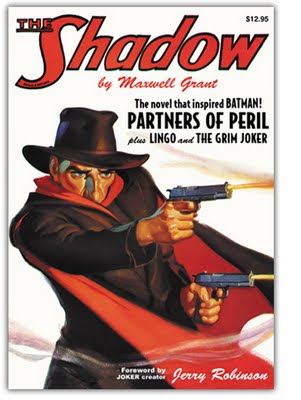 The Shadow is a collection of serialized dramas, originally in pulp magazines, then on 1930s radio and then in a wide variety of media, that follow the exploits of the title character, a crime-fighting vigilante with psychic powers. One of the most famous pulp heroes of the 20th century, The Shadow has been featured in comic books, comic strips, television, video games, and at least five motion pictures. The radio drama is well-remembered for those episodes voiced by Orson Welles.
The Shadow is a collection of serialized dramas, originally in pulp magazines, then on 1930s radio and then in a wide variety of media, that follow the exploits of the title character, a crime-fighting vigilante with psychic powers. One of the most famous pulp heroes of the 20th century, The Shadow has been featured in comic books, comic strips, television, video games, and at least five motion pictures. The radio drama is well-remembered for those episodes voiced by Orson Welles.Introduced as a mysterious radio narrator by David Chrisman, William Sweets, and Harry Engman Charlot for Street and Smith Publications, The Shadow was fully developed and transformed into a pop culture icon by pulp writer Walter B. Gibson.
The Shadow debuted on July 31, 1930, as the mysterious narrator of the Street and Smith radio program Detective Story Hour. After gaining popularity among the show's listeners, the narrator became the star of The Shadow Magazine on April 1, 1931, a pulp series created and primarily written by the prolific Gibson.
Over the years, the character evolved. On September 26, 1937, The Shadow radio drama officially premiered with the story "The Deathhouse Rescue", in which the character had "the power to cloud men's minds so they cannot see him." This was a contrivance for the radio; in the magazine stories, The Shadow did not have the ability to become literally invisible; he influenced the minds of his opponents by making them see him a few feet to the right or left of where he really stood. The effect of having this cloaked figure laughing while he was being shot at point-blank range was, at the least, unsettling.
Even after decades, the unmistakable introduction from The Shadow radio program, long-intoned by actor Frank Readick Jr., has earned a place in the American idiom: "Who knows what evil lurks in the hearts of men? The Shadow knows!" These words were accompanied by an ominous laugh and a musical theme, Camille Saint-Saëns' Le Rouet d'Omphale ("Omphale's Spinning Wheel", composed in 1872). At the end of each episode, The Shadow reminded listeners, "The weed of crime bears bitter fruit. Crime does not pay.... The Shadow knows!"

Comments
Post a Comment